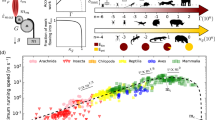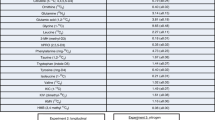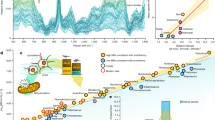Abstract
Vertebrates generally possess well developed capacities for anaerobic metabolism, resulting in formation of lactic acid. Those capacities have traditionally been interpreted in terms of adaptation to hypoxic environments or to special situations such as diving. However, anaerobic metabolism in striated muscle tissue is frequently a major source of ATP utilized during periods of intense activity. The evolutionary significance of anaerobically supported activity has not been discussed, although the interrelationships of capacities for aerobiosis and activity have received considerable attention1. We present here evidence that the pattern of activity metabolism utilized by extant species probably dates back to the earliest vertebrates. It is also postulated that the evolution of extensive capacity for anaerobically supported burst activity may have been closely related to the evolution of vertebrates from invertebrate chordates.
This is a preview of subscription content, access via your institution
Access options
Subscribe to this journal
Receive 51 print issues and online access
$199.00 per year
only $3.90 per issue
Buy this article
- Purchase on Springer Link
- Instant access to full article PDF
Prices may be subject to local taxes which are calculated during checkout
Similar content being viewed by others
References
Martin, R. D. Nature 283, 335–336 (1980).
Schmidt-Nielsen, K. Animal Physiology: Adaptation and Environment (Cambridge University Press, 1979).
Bennett, A. F. & Licht, P. Comp. Biochem. Physiol. 48A, 319–327 (1974).
Bennett, A. F. & Licht, P. J. comp. Physiol. 81, 177–188 (1972).
Ruben, J. A. & Battalia, D. E. J. exp. Zool. 208, 73–76 (1979).
Black, E. C. J. Fish Res. Bd Canada 12, 917–929 (1955).
Bennett, A. Comp. Biochem. Physiol. 46A, 673–690 (1973).
Eckert, R. & Randall, D. Animal Physiology (Freeman, San Francisco, 1978).
Bennett, A. F. A. Rev. Physiol. 40, 447–469 (1978).
Phillips, J. W., McKinney, R. J. W., Hird, F. J. R. & Macmillan, D. L. Comp. Biochem. Physiol. 56B, 427–433 (1977).
Burke, E. M. Biol. Bull. 156, 157–168 (1979).
Krogh, A. Comparative Physiology of Respiratory Mechanisms (University of Pennsylvania Press, Philadelphia, 1941).
de Zwan, A., Thompson, R. J. & Livingstone, D. R. J. comp. Physiol. B 137, 105–114 (1980).
Piiper, J., Meyer, M. & Drees, F. Respirat. Physiol. 16, 290–303 (1972).
Romer, A. S. Vertebrate Paleontology (University of Chicago Press, 1966).
Romer, A. S. & Parsons, T. S. The Vertebrate Body (Saunders, Philadelphia, 1977).
Bennett, A. F. & Ruben, J. A. Science 206, 649–654 (1979).
Halstead, L. B. The Pattern of Vertebrate Evolution (Freeman, San Francisco, 1968).
Moy-Thomas, J. A. & Miles, R. S. Paleozoic Fishes (Saunders, Philadelphia, 1971).
Author information
Authors and Affiliations
Rights and permissions
About this article
Cite this article
Ruben, J., Bennett, A. Antiquity of the vertebrate pattern of activity metabolism and its possible relation to vertebrate origins. Nature 286, 886–888 (1980). https://doi.org/10.1038/286886a0
Received:
Accepted:
Issue Date:
DOI: https://doi.org/10.1038/286886a0
This article is cited by
-
Anoxic survival of the Pacific hagfish (Eptatretus stoutii)
Journal of Comparative Physiology B (2011)
-
Intense exercise, bone structure and blood calcium levels in vertebrates
Nature (1981)
Comments
By submitting a comment you agree to abide by our Terms and Community Guidelines. If you find something abusive or that does not comply with our terms or guidelines please flag it as inappropriate.



